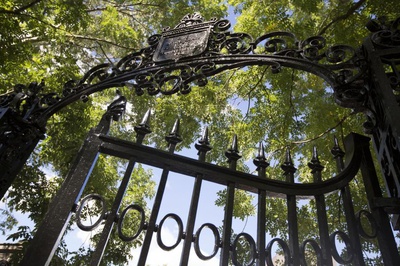
News
Nearly 200 Harvard Affiliates Rally on Widener Steps To Protest Arrest of Columbia Student

News
CPS Will Increase Staffing At Schools Receiving Kennedy-Longfellow Students

News
‘Feels Like Christmas’: Freshmen Revel in Annual Housing Day Festivities

News
Susan Wolf Delivers 2025 Mala Soloman Kamm Lecture in Ethics

News
Harvard Law School Students Pass Referendum Urging University To Divest From Israel
The Architectural Origins Of the Carpenter Center
LE CORBUSIER has vigorously expressed his theory of design in the Carpenter Center for the Visual Arts. However hostile or friendly its reception here may be, it is one of the most important buildings ever constructed at Harvard.
The harsh, raw severity of Le Corbusier jars a world conditioned to softer, more comfortable art forms, but it also establishes a conspicuous point of evolution in modern architecture. Into the Visual Arts Center Le Corbusier has brought all the major tenets of this evolution.
Since World War II, the integral parts of Le Corbusier design have consisted of pillar foundations, glass walls, sun breaks, roof terraces, and schemes free from orthodox, exterior influences. The Visual Arts Center unites all of these basic factors.
The Carpenter Center, Le Corbusier's first building in North America, derives its character from some of the most important of Le Corbusier's designs. The glass walls of the upper levels of the Center evidently appear originally in the Refuge City of the Salvation Army, built in Paris in 1920. The glass blocks which line one wall of the front elevation were used similarly in the Swiss Pavilion of Paris's University City in 1930. And the austere interior, though noticeable in virtually every Le Corbusier work, especially resembles that of the Villa Sarabhai which was erected in 1955.
The studios of the center are shielded from direct sunlight by concrete breakers. The exact positioning of these visors is not duplicated in any previous Le Corbusier work but is vaguely similar to those used in the government buildings of Chandigarh, India, and in designs for a proposed construction in Algiers which was never realized.
The pedestrian ramp which passes through the center of the building appears in the designs which Le Corbusier submitted for the Palace of the Soviets in 1931, and was previously included in the Savoye Villa of Poissy, France. The interplay of levels which has come to characterize many of Le Corbusier's recent buildings is largely missing from the Visual Arts Center. The sculptured gracefulness of the Chapel of Ronchamp and the Phillips Pavilion of the Brussels World's Fair finds itself in an abbreviated form in the circular wings of the center and in a distant sort of way in the sweeping slant of its ramp.
Le Corbusier is, in outlook, a logician -- his thinking appears in patterns of severe, and consequently cold, equations. And his theories of design follow these patterns of thought. He places emphasis on industrial functionalism in his art and he pleads with architecture to keep pace with a changing industrial society. He describes the need for a technology which will serve vast populations and communities of people with due equality. The solution he finds for that need is in the rawness and the flexibility of concrete and the other austere materials which he seems to believe constitute an absolute return to nature.
Want to keep up with breaking news? Subscribe to our email newsletter.
From Our Advertisers

Over 300+ courses at prestigious colleges and universities in the US and UK are at your disposal.

With innovative financial tools combined with financial education, Collegiate empowers students to take control of their finances and build confidence in their money management skills.

Serve as a proctor for Harvard Summer School (HSS) students, either in the Secondary School Program (SSP), General Program (GP), or Pre-College Program.

With an increasingly competitive Law School admissions process, it's important to understand what makes an applicant stand out.

Welcome to your one-stop gifting destination for men and women—it's like your neighborhood holiday shop, but way cooler.

Admit Expert is a premium MBA admissions consulting company, helping candidates secure admission to top B-schools across the globe with significant scholarships.
